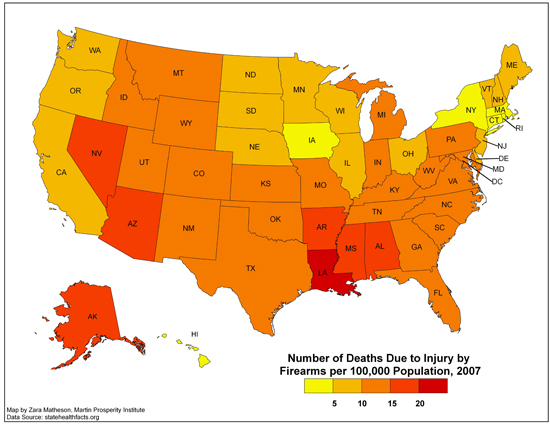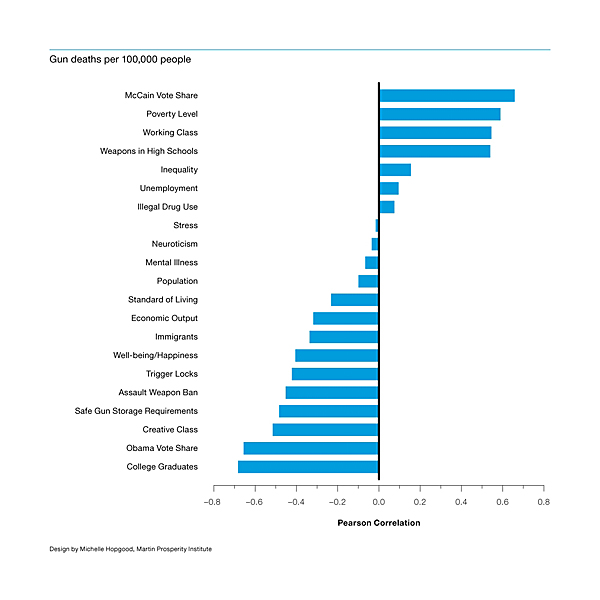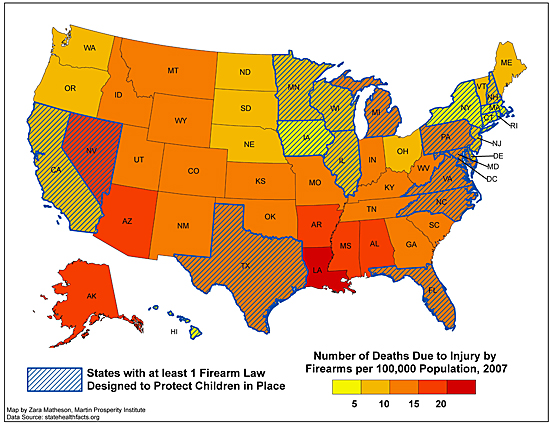The Geography of Gun Deaths
Terrible tragedies like last week's mass shootings in Tucson cause us to search for deeper answers. Many were quick to blame America's divisive and vitriolic political culture for the violence; others portray the shooter as an unhinged, clinically deranged person with his own unfathomable agenda. Arizona has been ground zero for the battle over immigration. Were the state's political and economic travails a contributing factor? There has been some talk about guns, too. Might tighter gun control laws have made a difference?
The map above charts firearm deaths for the 50 states plus the District of Columbia. Note that these figures include accidental shootings, suicides, even acts of self-defense, as well as crimes. As of 2007, 10.2 out of every 100,000 people were killed by firearms across the United States, but that rate varies dramatically from state to state. In Hawaii, at the low end, it was 2.6 per 100,000; in New York and New Jersey it was 5.0 and 5.2 respectively. At the high end, 21.7 out of every 100,000 residents of the District of Columbia were killed by guns, 20.2 in Louisiana, 18.5 in Mississippi, and 17.8 in Alaska. Arizona ranked eighth nationally, with 15.1 deaths per 100,000.
With these data in hand, I decided to look at the factors associated with gun deaths at the state level. With the help of my colleague Charlotta Mellander, we charted the statistical correlations between firearm deaths and a variety of psychological, economic, social, and political characteristics of states. As usual, I point out that correlation does not imply causation, but simply points to associations between variables.
It is commonly assumed that mental illness or stress levels trigger gun violence. But that's not borne out at the state level. We found no statistical association between gun deaths and mental illness or stress levels. We also found no association between gun violence and the proportion of neurotic personalities.
Images of drug-crazed gunmen are a commonplace: Guns and drug abuse are presumed to go together. But, again, that was not the case in our state-level analysis. We found no association between illegal drug use and death from gun violence at the state level.
Some might think gun violence would be higher in states with higher levels of unemployment and higher levels of inequality. But, again, we found no evidence of any such association with either of these variables.
So what are the factors that are associated with firearm deaths at the state level?
Poverty is one. The correlation between death by gun and poverty at the state level is .59.
An economy dominated by working class jobs is another. Having a high percentage of working class jobs is closely associated with firearm deaths (.55).
And, not surprisingly, firearm-related deaths are positively correlated with the rates of high school students that carry weapons on school property (.54).
What about politics? It's hard to quantify political rhetoric, but we can distinguish blue from red states. Taking the voting patterns from the 2008 presidential election, we found a striking pattern: Firearm-related deaths were positively associated with states that voted for McCain (.66) and negatively associated with states that voted for Obama (-.66). Though this association is likely to infuriate many people, the statistics are unmistakable. Partisan affiliations alone cannot explain them; most likely they stem from two broader, underlying factors - the economic and employment makeup of the states and their policies toward guns and gun ownership.
Firearm deaths were far less likely to occur in states with higher levels of college graduates (-.64) and more creative class jobs (-.52).
Gun deaths were also less likely in states with higher levels of economic development (with a correlation of -.32 to economic output) and higher levels of happiness and well-being (-.41).
And for all the terrifying talk about violence-prone immigrants, states with more immigrants have lower levels of gun-related deaths (the correlation between the two being -.34).
And what about gun control? As of July 29 of last year, Arizona became one of only three states that allows its citizens to carry concealed weapons without a permit. Might tighter gun control laws make a difference? Our analysis suggests that they do.
The map overlays the map of firearm deaths above with gun control restrictions by state. It highlights states which have one of three gun control restrictions in place - assault weapons' bans, trigger locks, or safe storage requirements.
Firearm deaths are significantly lower in states with stricter gun control legislation. Though the sample sizes are small, we find substantial negative correlations between firearm deaths and states that ban assault weapons (-.45), require trigger locks (-.42), and mandate safe storage requirements for guns (-.48).
While the causes of individual acts of mass violence always differ, our analysis shows fatal gun violence is less likely to occur in richer states with more post-industrial knowledge economies, higher levels of college graduates, and tighter gun laws. Factors like drug use, stress levels, and mental illness are much less significant than might be assumed.


